In this tutorial, we will be looking at how to perform a backhand banana flick (so named because of the curved flight of the ball) return of serve in table tennis/ping-pong. The flick (or flip) is an aggressive return used by the receiver to prevent the server from making a strong third ball attack at the worst, and at best to set up a fourth ball attack for the receiver.
Ready Position

© Greg Letts
Points to look for:
- The server has completed his serve, and the ball is on its way to the receiver, who is in his basic ready position. He is hoping for a long serve that he can attack with a loop, but is also ready to move in case his opponent serves a short serve.
- The receiver was expecting the ball to come to his backhand from the original positioning of the server, so he is in a wide stance, with his right foot slightly in front of his left (i.e. a backhand stance). His bat is held above and behind the playing surface, and is slightly to the backhand side of a neutral position.
- His opponent is serving from the backhand corner, so the player is standing a little further towards his backhand side. Also, since the player has a longer reach on his forehand side, that will also make the player stand a little to the left of the center of the line of play.
Moving Towards The Ball

© Greg Letts
The ball has bounced on the table, and the receiver has recognized that the serve will be short and to his backhand, and he is moving into position to play his stroke.
Points to look for:
- The player is watching the ball closely, and is starting to move his right shoulder forward, while turning a little to his left.
- The free arm is being used to help balance the player while he is reaching for the ball.
Start Of Backswing
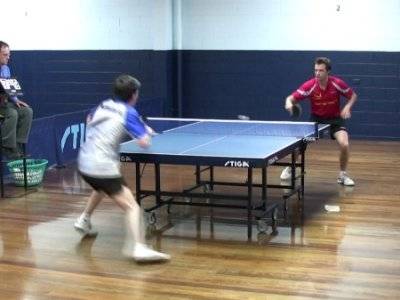
© Greg Letts
The ball has crossed the net, and the player is about to step forward with his right foot so that he will be in position to play the flick.
Points to look for:
- The player is continuing to watch the ball right up to the point of contact, in order to make sure he can adjust to any changes in the ball’s movement.
- The player has reached down towards the ball, with his elbow higher than his hand, and his wrist cocked down. This will increase the amount of forearm and wrist snap the player can achieve, and will increase the amount of speed and spin the player can put on the ball.
- The free arm has moved a little to the player’s left to help maintain good balance.
Middle Of Backswing
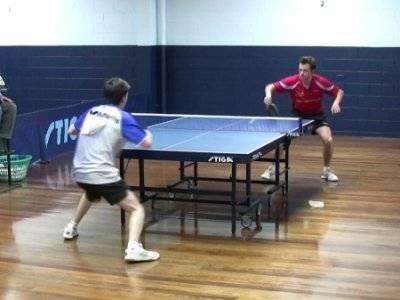
© Greg Letts
The player is moving into position to play the backhand flick, and is continuing his backswing at the same time.
Points to look for:
- The player is continuing to watch the ball right up to the point of contact, in order to make sure he can adjust to any changes in the ball’s movement.
- The player has dropped his racket even further, and he now has a very noticeable cocking of his wrist.
- The players right forearm is pointing towards the ball.
- The free arm has moved further to the player’s left to help maintain good balance.
End Of Backswing
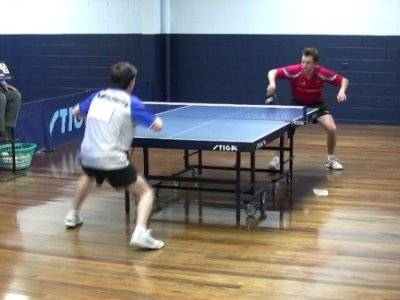
© Greg Letts
The player has moved his right foot into position, and has finished his backswing.
Points to look for:
- The player’s forearm is still pointing forward towards the ball, in contrast to the ordinary flick in which the forearm usually points fairly perpendicular to the ball’s flight.
- The player has continued to cock his wrist, and now the tip of the bat is actually pointing almost straight down, with the handle pointing up. Contrast this position to that of the traditional flick.
- The playing arm would be under great tension at this point, since the wrist is fully cocked and the forearm is also bent quite severely at the elbow. It is similar to a spring that has been wound up and is ready to be let loose.
Contact With The Ball

© Greg Letts
The player has begun to swing forward in order to make contact with the ball.
Points to look for:
- The player has started to snap his wrist and forearm both forward and sideways, rotating around the elbow and snapping the wrist in the same direction to increase the speed of the bat even further. The heavy blurring of the bat and lesser blurring of the elbow and forearm are evidence of this fast motion.
- In comparison, the upper arm and shoulder have moved comparatively little, indicating that the stroke is mainly generating its effect from the forearm and wrist snap.
- The player is attempting to contact the ball near to the top of its bounce. Contacting the ball at this point reduces the amount of lift required to get the ball over the net, which allows the player to put more speed on the ball, and also increases the amount of angles that the player can achieve. It also gives the player a few more inches of backswing to get the bat moving fast before contact is made with the ball.
- Contact with the ball is made much more on the side of the ball than in the ordinary flick – as you can see from the comparative photo. This gives the return a curved flight path.
- Although not all of the racket speed is converted into topspin (there is a significant amount of sidespin put on the ball), the ball still retains a heavy amount of topspin due to the fact that the extra torqueing of the wrist and forearm have increased the overall amount of spin that can be produced.
Start Of Follow Through
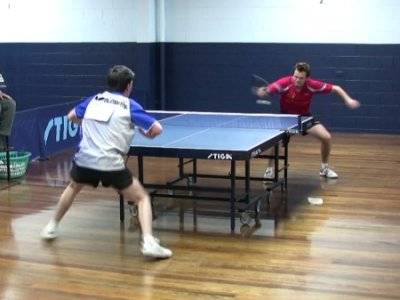
© Greg Letts
The ball is on its way towards the net, and the player is beginning his follow through.
Points to look for:
- The bat is travelling upwards and a little forwards, and is continuing to move in a semi-circular direction when viewed from the front, as shown by following the blurred path of the racket. From a sideways perspective, the bat has travelled forward and upward at a roughly 45 degree angle.
- Notice how stationary the player’s head and body have been throughout the stroke, indicating excellence balance and positioning.
- Notice also how the left arm has continued to swing out to the left, acting as a counterweight throughout the stroke.
Middle Of Follow Through

© Greg Letts
The ball is on its way over the net, and the player has almost finished his follow through.
Points to look for:
- As it is possible to see from the photograph, the player has flicked the ball crosscourt.
- The bat has almost finished its travel, as the player has straightened his arm fully.
- The follow through is going to finish at around shoulder height. Less follow through is needed on the backhand flick since it is easier to use the wrist on the backhand side.
End Of Follow Through

© Greg Letts
The ball has crossed the net, and the player has finished his follow through.
Points to look for:
- The player has finished his follow through with his playing arm fully extended. His free arm is also fully extended in the opposite direction, allowing the player to maintain his balance.
- The follow through has finished at shoulder height. Too much follow through would increase the player’s recovery time, which would be less than ideal considering how close he is to the table.
Start Of Return To Ready Position
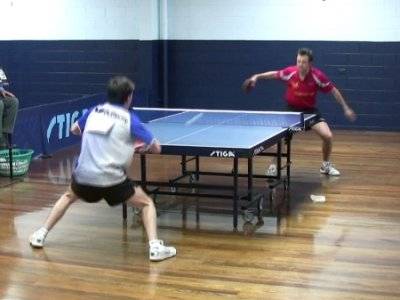
© Greg Letts
The player is now beginning to return to his ready position after stroking the ball.
Points to look for:
- The player is now pushing off his right leg to get back into his position. .
- The player is pushing up with his legs and moving his torso back up into his ready position.
- The playing arm only needs to be dropped slightly to be returned to its basic neutral position.
- The player is now focusing on how his opponent is handling his flick.

